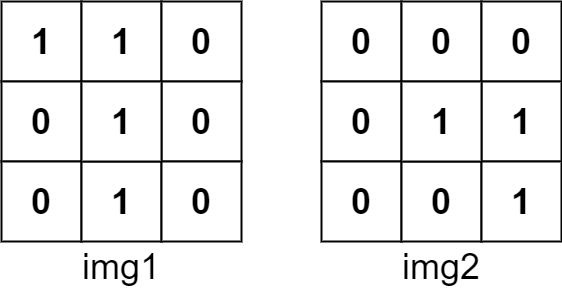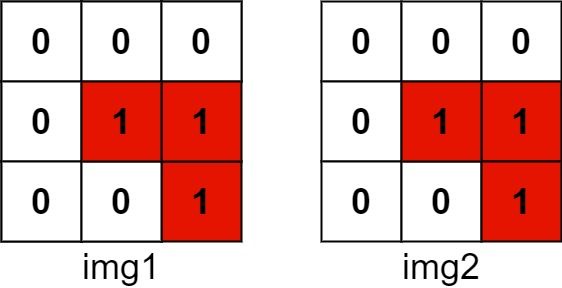| comments | difficulty | edit_url | tags | ||
|---|---|---|---|---|---|
true |
Medium |
|
You are given two images, img1 and img2, represented as binary, square matrices of size n x n. A binary matrix has only 0s and 1s as values.
We translate one image however we choose by sliding all the 1 bits left, right, up, and/or down any number of units. We then place it on top of the other image. We can then calculate the overlap by counting the number of positions that have a 1 in both images.
Note also that a translation does not include any kind of rotation. Any 1 bits that are translated outside of the matrix borders are erased.
Return the largest possible overlap.
Example 1:
Input: img1 = [[1,1,0],[0,1,0],[0,1,0]], img2 = [[0,0,0],[0,1,1],[0,0,1]] Output: 3 Explanation: We translate img1 to right by 1 unit and down by 1 unit.The number of positions that have a 1 in both images is 3 (shown in red).

Example 2:
Input: img1 = [[1]], img2 = [[1]] Output: 1
Example 3:
Input: img1 = [[0]], img2 = [[0]] Output: 0
Constraints:
n == img1.length == img1[i].lengthn == img2.length == img2[i].length1 <= n <= 30img1[i][j]is either0or1.img2[i][j]is either0or1.
class Solution:
def largestOverlap(self, img1: List[List[int]], img2: List[List[int]]) -> int:
n = len(img1)
cnt = Counter()
for i in range(n):
for j in range(n):
if img1[i][j]:
for h in range(n):
for k in range(n):
if img2[h][k]:
cnt[(i - h, j - k)] += 1
return max(cnt.values()) if cnt else 0class Solution {
public int largestOverlap(int[][] img1, int[][] img2) {
int n = img1.length;
Map<List<Integer>, Integer> cnt = new HashMap<>();
int ans = 0;
for (int i = 0; i < n; ++i) {
for (int j = 0; j < n; ++j) {
if (img1[i][j] == 1) {
for (int h = 0; h < n; ++h) {
for (int k = 0; k < n; ++k) {
if (img2[h][k] == 1) {
List<Integer> t = List.of(i - h, j - k);
ans = Math.max(ans, cnt.merge(t, 1, Integer::sum));
}
}
}
}
}
}
return ans;
}
}class Solution {
public:
int largestOverlap(vector<vector<int>>& img1, vector<vector<int>>& img2) {
int n = img1.size();
map<pair<int, int>, int> cnt;
int ans = 0;
for (int i = 0; i < n; ++i) {
for (int j = 0; j < n; ++j) {
if (img1[i][j]) {
for (int h = 0; h < n; ++h) {
for (int k = 0; k < n; ++k) {
if (img2[h][k]) {
ans = max(ans, ++cnt[{i - h, j - k}]);
}
}
}
}
}
}
return ans;
}
};func largestOverlap(img1 [][]int, img2 [][]int) (ans int) {
type pair struct{ x, y int }
cnt := map[pair]int{}
for i, row1 := range img1 {
for j, x1 := range row1 {
if x1 == 1 {
for h, row2 := range img2 {
for k, x2 := range row2 {
if x2 == 1 {
t := pair{i - h, j - k}
cnt[t]++
ans = max(ans, cnt[t])
}
}
}
}
}
}
return
}function largestOverlap(img1: number[][], img2: number[][]): number {
const n = img1.length;
const cnt: Map<number, number> = new Map();
let ans = 0;
for (let i = 0; i < n; ++i) {
for (let j = 0; j < n; ++j) {
if (img1[i][j] === 1) {
for (let h = 0; h < n; ++h) {
for (let k = 0; k < n; ++k) {
if (img2[h][k] === 1) {
const t = (i - h) * 200 + (j - k);
cnt.set(t, (cnt.get(t) ?? 0) + 1);
ans = Math.max(ans, cnt.get(t)!);
}
}
}
}
}
}
return ans;
}

